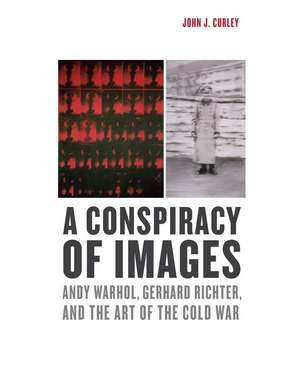A Conspiracy of Images: Andy Warhol, Gerhard Richter, and the Art of the Cold War
Autor John J. Curleyen Limba Engleză Hardback – 3 dec 2013
An important new look at Cold War art on both sides of the Atlantic
In October 1962, a set of blurred surveillance photographs brought the world to the brink of nuclear apocalypse during the Cuban missile crisis. The pictures themselves demonstrated little, and explanatory captions were necessary to identify the danger for the public. In the following months, two artists with antithetical backgrounds arrived at a similar aesthetic: Andy Warhol, who began his career as a commercial artist in New York City, turned to the silkscreened replication of violent photographs. Gerhard Richter, who began as a mural painter in socialist Dresden, East Germany, painted blurred versions of personal and media photographs. In A Conspiracy of Images, author John J. Curley explores how the artists’ developing aesthetic approaches were informed by the political agency and ambiguity of images produced during the Cold War, particularly those disseminated by the mass media on both sides. As the first scholarly consideration of the visual conditions of the Cold War, A Conspiracy of Images provides a new and compelling transatlantic model for Cold War art history.
In October 1962, a set of blurred surveillance photographs brought the world to the brink of nuclear apocalypse during the Cuban missile crisis. The pictures themselves demonstrated little, and explanatory captions were necessary to identify the danger for the public. In the following months, two artists with antithetical backgrounds arrived at a similar aesthetic: Andy Warhol, who began his career as a commercial artist in New York City, turned to the silkscreened replication of violent photographs. Gerhard Richter, who began as a mural painter in socialist Dresden, East Germany, painted blurred versions of personal and media photographs. In A Conspiracy of Images, author John J. Curley explores how the artists’ developing aesthetic approaches were informed by the political agency and ambiguity of images produced during the Cold War, particularly those disseminated by the mass media on both sides. As the first scholarly consideration of the visual conditions of the Cold War, A Conspiracy of Images provides a new and compelling transatlantic model for Cold War art history.
Preț: 394.47 lei
Preț vechi: 452.01 lei
-13% Nou
Puncte Express: 592
Preț estimativ în valută:
75.48€ • 78.30$ • 62.94£
75.48€ • 78.30$ • 62.94£
Carte tipărită la comandă
Livrare economică 27 martie-02 aprilie
Preluare comenzi: 021 569.72.76
Specificații
ISBN-13: 9780300188431
ISBN-10: 0300188439
Pagini: 296
Ilustrații: 32 color + 136 b-w illus.
Dimensiuni: 203 x 254 x 27 mm
Greutate: 1.27 kg
Editura: Yale University Press
Colecția Yale University Press
ISBN-10: 0300188439
Pagini: 296
Ilustrații: 32 color + 136 b-w illus.
Dimensiuni: 203 x 254 x 27 mm
Greutate: 1.27 kg
Editura: Yale University Press
Colecția Yale University Press
Notă biografică
John J. Curley is assistant professor of art history at Wake Forest University.
Recenzii
“Curley's thoughtful and carefully researched book promotes Warhol and Richter to positions of cultural centrality, thereby deepening our understanding not only of their work but of their perilous times—and ours.”—Richard Kalina, Art in America
